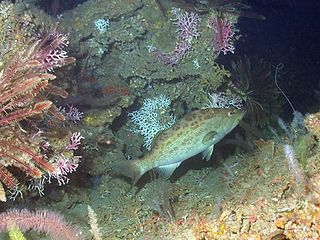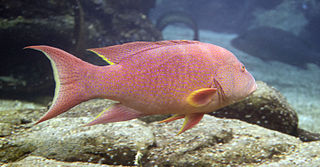
Mycteroperca bonaci, the black grouper, black rockfish or marbled rockfish, is a species of marine ray-finned fish, a grouper from the subfamily Epinephelinae which is part of the family Serranidae, which also includes the anthias and sea basses. Other fish are sometimes called the black grouper including the similar gag grouper, the misty grouper, and the warsaw grouper. This species is found in the western Atlantic Ocean from the northeastern United States to Brazil.

The belted sandfish, also known as the dwarf sea bass or stubby sea bass, is a species of marine ray-finned fish, a sea bass from the subfamily Serraninae, classified as part of the family Serranidae which includes the groupers and anthias. It is found in the western Atlantic Ocean. This species is found in the aquarium trade.

The gag grouper, also known as velvet rockfish, the gag, or charcoal belly, is a species of marine ray-finned fish, a grouper from the subfamily Epinephelinae which is part of the family Serranidae, which also includes the anthias and sea basses. It comes from warmer parts of the West Atlantic, including the Caribbean and Gulf of Mexico. It is a drab, mottled-gray fish lacking the distinguishing features of most other groupers. Its pattern of markings resemble the box-shaped spots of the black grouper. It lacks the streamer-points on the tail fin that scamp and yellowmouth grouper have and lacks yellow coloration around the mouth.

The rock beauty, also known as corn sugar, coshubba, rock beasty, catalineta, and yellow nanny, is a species of marine ray-finned fish, a marine angelfish belonging to the family Pomacanthidae. It is found in the western Atlantic Ocean.

The snowy grouper is a species of marine ray-finned fish, a grouper from the subfamily Epinephelinae which is part of the family Serranidae, which also includes the anthias and sea basses. It is found in the western Atlantic Ocean.

Pseudanthias bicolor, the bicolor anthias or yellowback basslet is a species of marine ray-finned fish from the subfamily Anthiinae of the family Serranidae, the groupers and sea basses. It is from the Indo-Pacific Ocean. It occasionally makes its way into the aquarium trade. It grows to a size of 13 cm in length.

Pseudanthias rubrizonatus, the red-belted anthias, liliac-tip basslet, deepsea fairy basslet, lilac-tipped seaperch, redband anthias, red-band basslet or redbar anthias is a species of marine ray-finned fish, an anthias from the subfamily Anthiinae part of the family Serranidae, the groupers and sea basses. It is found in the Indo-Pacific. It occasionally makes its way into the aquarium trade. It grows to a size of 12 cm in length.

Cephalopholis fulva, the coney or the butterfish, is a species of marine ray-finned fish, a grouper from the subfamily Epinephelinae which is in the family Serranidae which also includes the anthias and sea basses. It is found in the western Atlantic. It is associated with reefs and is a quarry species for commercial and recreational fisheries. It can be found in the aquarium trade.

Serranus tigrinus, the harlequin bass, is a species of marine ray-finned fish, a sea bass from the subfamily Serraninae, which is a part of the family Serranidae, which also includes the groupers and the anthias. It can be found in the western Atlantic Ocean, and also in aquarium trades.

Hypoplectrus unicolor, the butter hamlet or yellowtail hamlet, is a species of marine ray-finned fish, a sea bass from the subfamily Serraninae which is part of the family Serranidae, which also includes the groupers and anthias. It occurs in the western central Atlantic Ocean and occasionally makes its way into the aquarium trade.

Hypoplectrus indigo, the indigo hamlet, is a species of marine ray-finned fish, a sea bass from the subfamily Serraninae which is part of the family Serranidae, which also includes the groupers and anthias. It is found in the central western Atlantic Ocean. It occasionally makes its way into the aquarium trade.

The scamp grouper, also known as scamp, is a species of marine ray-finned fish, a grouper from the subfamily Epinephelinae which is part of the family Serranidae, which also includes the anthias and sea basses. It is found in the western Atlantic Ocean.
The yellowmouth grouper, also known as the crossband rockfish, grey mannock, hamlet, harlequin rockfish, princess rockfish, rockfish, salmon grouper, salmon rock fish or scamp, is a species of marine ray-finned fish, a grouper from the subfamily Epinephelinae which is part of the family Serranidae, which also includes the anthias and sea basses. It is found in the Caribbean and in the tropical waters of the Atlantic Ocean. It is also found in pockets in Brazil. It is a fairly large fish and it gets its name from the yellow around its mouth.
Liopropoma carmabi, the candy basslet, is a species of fish in the family Serranidae.

Liopropoma is a genus of marine ray-finned fish, related to the groupers and included in the subfamily Epinephelinae, part of the family Serranidae, which also includes the anthias and sea basses. They are sometimes seen in the marine aquarium trade.

Liopropoma santi, the spot-tail golden bass, is a species of marine ray-finned fish, related to the groupers and classified within the subfamily Epinephelinae of the family Serranidae. It has been collected from deep reefs off Curaçao, southern Caribbean; it is the deepest occurring Liopropoma species in the Atlantic Ocean.

The Clarion angelfish is a species of marine ray-finned fish, a marine angelfish belonging to the family Pomacanthidae. It is found in the eastern Pacific Ocean, almost exclusively near islands off the Pacific coast of Mexico.

The white-edged lyretail, also known as the white-edge coronation trout, lyretail grouper, lyretail trout, white-edged lyretail-cod or white-fringed moontail-bass, is a species of marine ray-finned fish, a grouper from the subfamily Epinephelinae which is part of the family Serranidae, which also includes the anthias and sea basses. It is found in the Indo-Pacific region but it is an uncommon species.

The rainfordia, also known as the flathead perch or Rainford's perch, is a species of marine ray-finned fish, related to the groupers and classified within the subfamily Epinephelinae of the family Serranidae. It is found in the eastern Indian Ocean and in the Western Pacific Ocean. It is the only species in its monotypic genus.
Jeboehlkia is a monotypic genus of marine ray-finned fish, related to the groupers and classified within the subfamily Epinephelinae of the family Serranidae. It is a species of relatively deep water which is found in the western Atlantic Ocean. The only species in the genus is Jeboehlkia gladifer, the bladefin bass.


















